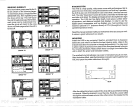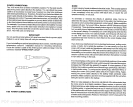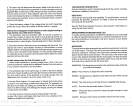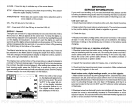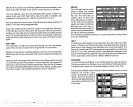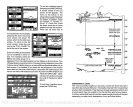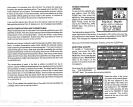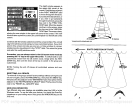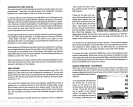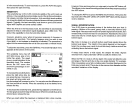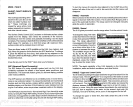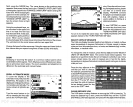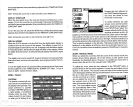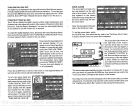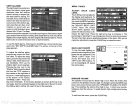
TRANSDUCER
CONE ANGLES
The sound
waves from the transducer
spread
out into the water in a cone
shaped
beam. This looks much like the
beam from
aflashlight.
The
angle
between
the outside
edges
of the cone is
the cone
angle.
Lowrance
offers a choice of transducers with either
an 8 or2O
degree
cone
angle.
Thetransducersupplied
withthe X-55 has
a2Odegree coneangle.
Typically,
wide cone
angle
transducers
(20 degrees)
are ideal for
operat-
ing
in shallow to medium
water
depths.
The 20
degree
cone
angle
allows
you
to see more of the underwaterworld.
In 1 Sfeet of waterthe 20
degree
cone
covers an area
about six feet across. The 8
degree
transducer
covers
only
about a two foot circle.
The
20
degree
transducer is
almost
always
the best to use in fresh
water,
the8
degree mostly
in salt water.
In a
deep
water
environment, (300
feet
-
fresh water,
100 feet
-
salt
water)
the narrow cone
angle
is more
desirable. Sincethe -ound
energyis
concentrated in
asmallerarea,
itcan
penetrate
to much
deeper depths.
Both
8
degree
and 20
degree
transducers
give
accurate bottom
readings,
eventhoughthe
bottom
signal
is muchwideronthe
2odegree
model. This
is because
you
are
seeing
more of the
bottom.
Remember,
the shallow
edge
of the
signal
showsyouthetrue depth.
The
restof the
signal tellsyou
whether
you
are over
rocks, mud,
etc.
if the cone
passes
over
a fish in shallow
water,
the
signal displayed
on the
X-55
may
not arch at all. This
is due to the narrow cone diameter
and the
resolution limitations
of the
display.
FISH
ARCHES
Fish arches
are created when
the cone of sound
passes
over a
fish. The
distance
to a fish when the cone first
strikes it is shown as "A" on the
next
page.
When
the center of the cone strikes
the
fish,
the distance
is shorter
as shown
"B". As the cone leaves the
fish,
the distance increases
again
as shown
in "C".
Very
small
fish
probably
will not arch at
all. Medium sized fish will show
a
partial
arch,
or a
shape
similar to an arch
if
they're
in
deep
water.
Large
fish will
arch,
but
turn the
sensitivity up
in
deeper
water to see the arch.
Because
of
waterconditions,
such as
heavy
surface
clutter, thermoclines,
etc.,
the
sensitivity
sometimes cannot be increased
enough
to
get
fish
arches.
One of the best
ways
to
get
fish arches is to
expand
or"zoom" a
segment
Now
press
the down arrow
key
until the screen shown at
right appears.
These
are the side scan win-
dows. Both
windows show the
digital depth
display
from the
transducer
pointed
at the bot-
tom
-
Not the side scan
trans-
ducer. The window
on the left
shows a Fish ID
symbol
when
______________
______________
the unit identifies
atarget
as a
________________
_______________
fish.
When this
happens,
the
digital depth display
at the
bottom of the window
changes
from
"DEPTH"
to "FISH" and shows the distance
from the side scan transducer
to the
target
shown as a fish
symbol.
The
window on the
right
shows
all return echoes. These echoes
appear
as
short,
horizontal lines. The thickerthe
Iine,thestrongerthe
return echo.
The distance
to these
targets
can be
determined
by comparing
the
position
of
the echo to the
range
markers
on the side of the
display.
To
change
the
range, press
the RANGE
key.
A new
menu
appears
at the
bottom of the
display.
Use the
up
or down arrow
keys
to
change
the
range
of the side scan mode
from ten to
sixtyfeet.
Eitherwait afew
seconds after
you've changed
the
range
and the menus will
automatically disappear
or
press
the CLEAR
key
to erase the menus.
SONAR OPERATION
-
AUTOMATIC
When the X-55 is first turned
on,
the Automatic feature is
enabled. This
is
indicated
by
the word "AUTO"
at the
top
of the screen. The Automatic
feature
adjusts
the
sensitivity
and
range
so
the bottom
signal
is
displayed
in
the lowerhalf of the screen at
____________________________
all times.
To turn Automatic
off,
first
press
the AUTO
key.
A menu
ap-
pears
at the
bottom of the
screen
above the left and
right
arrows.
Press the left arrow
key
to switch to the manual
mode. The
letters "Man"
ap-
pear
in the
upper
left corner of
the
display,
indicating
the unit
ftS
I) ________
t
K!
______
III
IIFTSH
36.5
FT]I[DEPTH
48.1
q89FT
0
12
29
28
9
36
PDF compression, OCR, web-optimization with CVISION's PdfCompressor



